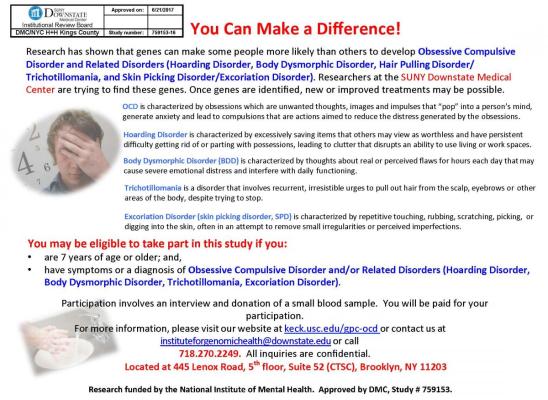BFRB Precision Medicine Initiative: New Update

Online test
Find out the severity of your symptoms with this free online test
2021 was a busy year for the BFRB Precision Medicine Initiative (BPMI). Even with the ongoing challenges of the pandemic, researchers have remained committed to the precision medicine approach and advancing the goals of the BPMI. Projects are awaiting publication, data analysis is revealing new insights into Body Focused Repetitive Behaviors (BFRB), research is continuing, and support for treatment advancement remains strong. In a recent video update, John Piacentini, PhD and Jon E. Grant, JD, MD, members of the TLC Foundation for BFRBs Scientific Advisory Board join the TLC Foundation’s Interim Executive Director Jen Monteleone to take a look back at 2021 and share the latest from the BPMI. The message is one of hope and healing.
What is the BFRB Precision Medicine Initiative?
Precision medicine is a powerful approach to research and treatment that uses behavioral, genetic, and biological indicators to define an individual pattern of disease in order to develop individualized treatments. It has revolutionized treatment for other serious issues such as cancer treatments. Given that BFRBs seem to have genetic and neurobiological underpinnings, the TLC Foundation for BFRBs launched the BFRB Precision Medicine (BPM) Initiative in 2017, bringing the cutting-edge approach of precision medicine to the goal of finding new, more effective treatments for BFRBs.
With the help of its TLC scientific advisory board and collaborative partnerships, the TLC Foundation started the BFRB Precision Medicine Initiative (BPMI) to promote research and understanding around body focused-repetitive behaviors (BFRBs) bringing the power of precision medicine to BFRB research. The mission of the BPMI is to contribute to the knowledge base in ways that will lead to the development of innovative and targeted, individualized approaches to treatment that will dramatically improve treatment outcomes for people living with dermatilllomania, trichotillomania and related behaviors.
The goals of the BPMI go beyond just research into BFRBs:
- TLC and the BPMI share the goal of bringing the cutting-edge approach of precision medicine to the goal of finding new, more effective treatments for BFRBs.
- Support research endeavors in the area of BFRBs
- Collect and categorize data that will form the basis for new, more effective treatments for body-focused repetitive behaviors
- BPMI seeks to create the ability to develop each person's unique BFRB profile, identifying the motivations and habits that make up an individual's particular type of picking or pulling behavior.
- With the ability to identify individual BFRB profiles, treatments can be carefully tailored to each person’s psychological, genetic, and neurobiological factors and needs.
One of the reasons the BPMI was formed is because there has historically been little funding for BFRB research, so it has received little attention in the literature. Existing treatments are not optimal. Effective treatments depend on sound research. With that in mind, the TLC Foundation and the BPMI sought to change that dynamic by applying precision medicine’s cutting-edge approach to finding innovative, effective, and individualized treatments for people living with BFRBs.
Since that time, the BPMI has been at the forefront of research and support for the BFRB community. Their researchers have published a number of studies that have advanced the understanding of BFRBs and paved the way for new approaches to treatment.
The Update
The BPMIs research projects have yielded impressive results and are going beyond surface factors, looking deeper at individual differences and motivations. One of the highlights of 2021 was findings from the BPMI research team that identified five distinct hair pulling and skin picking subtypes. The identification of subtypes provides insight into the heterogeneity of BFRBs. These findings are an important step in the process of developing targeted, individualized treatments that fit people’s unique experiences with BFRBs. This pioneering research is nearing the final data analysis stage before developing clinical hypotheses that will test and tailor personalized treatment interventions.
Research projects have continued to expand and advance the understanding of BFRBs. Instead of only being able to examine one aspect of a person’s BFRB experience, researchers can now look at the data from multiple studies examining different aspects of BFRBs. Having the ability to look at all aspects of BFRBs from the surface behaviors to the psychological dynamics to brain-imaging is allowing researchers to gain a more thorough understanding of BFRBs and how they manifest.
One of the goals that was set for the BPMI for 2021 was to continued focus on neuroimaging to further expand the understanding of the neurobiological foundations of BFRBs. Neuroimaging studies have allowed unprecedented insight into how the brain functions in the presence of a BFRB.
Dr. Grant and Dr. Piacentini expanded on this ability to look at brain function and how it may play a role in developing effective, individualized treatments. One of the things that data has revealed is that there is a high reward component in the brains of people with BFRBs as compared to people who do not have a BFRB. In other words, they process “reward” differently, not unlike people with alcohol or drug addiction. These findings suggest that it may be helpful to explore the use of existing treatments that are helpful with other mental health disorders with similar dynamics. This approach may extend to both behavioral and pharmacological treatments. This is especially encouraging since there are currently no medications that are particularly effective for treating BFRBs. Research continues to look at these possibilities.
What’s Next?
2021 was a year that saw the publishing of new research and expanding knowledge of BFRBs. 2022 will see continued effort to support research to explore BFRBs in innovative ways. The data collection process will likely begin to wrap into treatment research. Armed with the most current and in-depth data available, researchers will continue their quest to find the most effective treatments for people living with BFRBs.
Things are unfolding quickly and, more than ever, there is hope for people living with BFRBs. The TLC Foundation for BFRBs Precision Medicine Initiative remains committed to applying the precision medicine approach to the goal of finding the most effective treatments for BFRBs.
Stay tuned for more updates!
Source: https://www.bfrb.org/blog/1-blog/694-hope-a-healing-tlc-foundation-bpm-update
Online test
Find out the severity of your symptoms with this free online test
Start your journey with SkinPick
Take control of your life and find freedom from skin picking through professional therapy and evidence-based behavioral techniques.
Start Now



